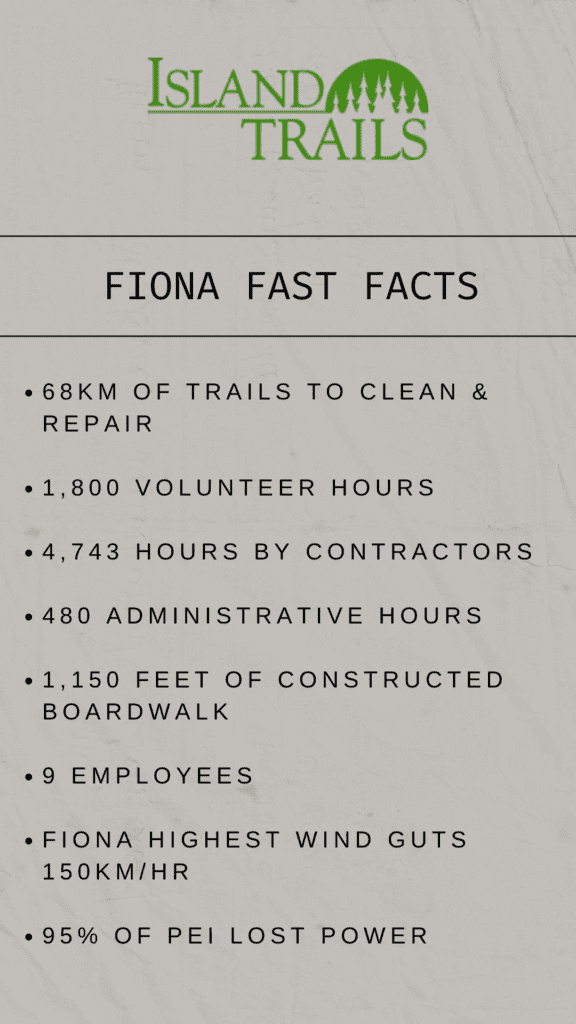Written by Tracey Gairns Brioux & Island Trails Board Members
Prince Edward Island Trails, Inc. (Island Trails) was established in 1994. The development of the woodland hiking trails component began in about 2003. Serious planning began for that trail in 2005, and permits, funding, and construction took place from 2008 to 2009. Six woodland trails (Black Marsh, Winter River, Gairloch Road, Forest Hill, Boughton River, Breadalbane) followed a similar but much-accelerated course. Their construction was completed in 2010. Subsequently, Bonshaw, Strathgartney, Forestview and Selkirk Forest Walking Trail were added to the Island Trails network of hiking, cycling and equestrian trails. Island Trails maintains all but Bonshaw and Strathgartney.
When theCOVID-199 pandemic struck, like everything else, Island Trails activity slowed. As the restrictions from COVID-19 began to ease, the trials became the most frequent they had ever been. Website traffic doubled in 2020-2021, and more people seemed to be looking for opportunities to get out of their homes and into nature. The future was looking bright.
Fiona
Hurricane Fiona was the costliest and most intense post-tropical cyclone in Canadian History. Fiona made landfall near Whitehead, Nova Scotia, on the morning of September 24 as a recently transitioned extratropical cyclone with hurricane-force winds. Environment Canada assessed Fiona’s maximum sustained winds at landfall to be around 105 mph (169 km/h). A peak wind gust of 111 mph (179 km/h) was recorded in Arisaig, Nova Scotia, with peak gusts in Prince Edward Island recorded at East Point at 93 MPH or 150 km/hr.
Fiona affected the four provinces of Atlantic Canada and Quebec. The storm caused significant flooding in southeastern New Brunswick, Prince Edward Island, northeastern Nova Scotia, and southern Newfoundland. Ninety-five percent of Prince Edward Island customers were powerless, and thousands of trees were knocked down and uprooted. PEI lost 40% of its woodlands and destroyed its trail systems.
Teacup Rock, a rock formation and local tourist attraction on the coast near Thunder Cove, Prince Edward Island, was destroyed after Hurricane Fiona struck. Fiona also caused severe erosion to the province’s dune system, particularly within the Prince Edward Island National Park. (source)
Robinsons Island was one of the community favourites in the island trail system, and it saw extensive damage during Fiona. The causeway to the Island was built in 1956 and destroyed by wind and waves during the storm. The province decided not to rebuild after the damages occurred. See- Broken road to Robinsons Island being removed rather than rebuilt– Article in CTV
The damage to the PEI Trail Network was extensive. Islanders and tourists who enjoyed using the trails, especially during COVID-19, could no longer do so due to safety concerns, and the trails were essentially wholly covered in fallen trees.

Post Fiona
Island Trails volunteers understood the importance of the Trail Network to Islanders and tourists and began working on opening the trails immediately after the storm. Between October 2022 and March 2023, over 1,300 volunteer hours were recorded, which amounts to over $66,000 in in-kind contributions by Island Trails volunteers.
Bryson Guptill, a longstanding member of the Island Trails board, reported that the first Island Trails 9 Trail system was to be tackled after Fiona was Winter River. Being one of the more popular trails, located about five kilometres north of Charlottetown, it seemed the most logistically appropriate trail to start with. The damage was almost indescribable. Bryson reported, “The trail was completely covered in downed trees that hid where the trail once was. It took a GPS to find the trail, and then volunteers had to climb over trees, which would take hours, to mark out where the trail would be with tape. The blockage of trees was so extensive in some areas that you may be able to get in a little way, but then you’ll find you can’t get by without actually crawling over or under the trees. Hence, it’s tough, and that can be disorienting.” The following are a few images from the very early stages of the cleanup.
Clean-up Begins/Funding Required
Within 6 months of Fiona, volunteers had put in a conservative estimate of 1,321 hours.
After months of hard work and heavy lifting, Island Trails recognized that they would require assistance to open the trails for use in the spring of 2023.
An application was submitted to the Canadian Red Cross’s Provincial Financial Assistance Program to continue opening the trails. In April, a project coordinator was hired to oversee the project, and a temporary trail crew and contractors were hired to work on the Boughton River, Forestview, and Breadalbane trails.
In the fall of 2022, The Government of Canada announced support for post-Fiona through the Hurricane Fiona Recovery Fund coordinated by the Atlantic Canada Opportunities Agency (ACOA).
November 2023 – March 2024
Island Trails manages 68 km of trails spread across nine different trail systems. After the trails were opened to full width, crews worked over the winter months to remove more fallen debris and clean up alongside the trails, which required another 748 hours of paid time. New chainsaws were purchased between November 2023 and March 2024, and a course on chainsaw safety, another on chainsaw maintenance, and a first aid course were taken.

